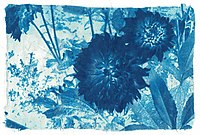 The Tetons and the Snake River, by Ansel Adams
The Tetons and the Snake River, by Ansel Adams Laborer's hands, by Doris Ulmann
Laborer's hands, by Doris Ulmann
Monochrome photography is photography where each position on an image can record and show a different amount of light (value), but not a different color (hue). The majority of monochrome photographs produced today are black-and-white, either from a gelatin silver process, or as digital photography. Other hues besides grey can be used to create monochrome photography, but brown and sepia tones are the result of older processes like the albumen print, and cyan tones are the product of cyanotype prints.
As monochrome photography provides an inherently less accurate reproduction than color photography, it is mostly used for artistic purposes and certain technical imaging applications.
Description
See also: History of photography
Although methods for photographing in color emerged slowly starting in the 1850s, monochrome imagery dominated photography until the mid–twentieth century. From the start, photographic recording processes such as the daguerreotype, the paper negative and the glass collodion negative did not render the color of light (although they were sensitive to some colors more than others). The result was a monochrome image.
Until the 1880s, photographic processes that were used for printing negatives—such as calotype, ambrotype, tintype, salt print and the albumen print—generally produced images with a variety of brown or sepia tones. Later processes moved toward a black-and-white image, although photographers have used toning solutions to convert silver in the image to silver sulphide, imparting a brown or sepia tone. Similarly, selenium toner produces a blue-black or purple image by converting silver into more stable silver selenide. Cyanotypes use iron salts rather than silver salts, producing blue images.
Most modern black-and-white films, called panchromatic films, record the entire visible spectrum. Some films are orthochromatic, recording visible light wavelengths shorter than 590 nanometers, in the blue to green range of the spectrum and are less sensitive to the longer wavelength range (i.e. orange-red) of the visible spectrum.
Modern techniques and uses


Black-and-white photography is considered by some to be more subtle and interpretive, and less realistic than color photography. Monochrome images are not direct renditions of their subjects, but are abstractions from reality, representing colors in shades of grey. In computer terms, this is often called greyscale. Black-and-white photography is considered by some to add a more emotional touch to the subject, compared with the original colored photography.
Monochrome images may be produced in a number of ways. Finding and capturing a scene having only variants of a certain hue, while difficult and uncommon in practice, will result in an image that technically qualifies as a monochrome photo. One can also artificially limit the range of color in a photo to those within a certain hue by using black-and-white film or paper, or by manipulating color images using computer software.
Color images can be converted to black and white on the computer using several methods, including desaturating the existing color RGB image so that no color remains visible (which still allows color channels to be manipulated to alter tones such as darkening a blue sky), or by converting the image to a greyscale version (which eliminates the colors permanently), using software programs like Photoshop. After software conversion to a monochrome image, one or more hues can replace the grey tones to emulate duotones, sepia, selenium or gold toned images or cyanotype, calotype or albumen prints.
Digital black-and-white cameras
Although digital images captured in color can be modified with a digital black and white process, some specialized cameras photograph natively in black and white with no option for color.
Black and white digital cameras are often designed without a Bayer filter, avoiding the demosaicing process and meaning that a camera will only capture raw luminance. This allows these specialized cameras to capture the full spectrum of available light.
Some feature films, including Blonde, were shot using specialized digital video equipment designed without a Bayer filter — rather than black and white film — in order to enable longer takes.
Leica M Monochrom is a digital camera in Leica Camera AG's rangefinder M series, and features a monochrome sensor. The camera was announced in May 2012.
Phase One IQ3 100MP Achromatic is a digital medium format camera with an ISO rating exceeding up to 51,200. The camera was released in 2017.
The Pentax K3 Mark III was released as a monochromatic version in 2023 to high demand.
Monochromatic modifiers
The use of the following modifiers can add a different aesthetic to images without software manipulation, each for their own unique purposes:
- Color filters
- Neutral density filters (gradual or standard ND filters)
- Polarizing filters
- Infrared filter
Astrophotography applications
Monochrome imaging for astrophotography is a popular technique among amateur astrophotographers. Modern monochrome cameras dispose of the color bayer matrix that sits in front of the sensor. This allows for specialized narrowband filters to be used, allowing the entire sensor area to be utilized for specific wavelengths of light emitted by many deep space objects. Hydrogen-alpha, a common wavelength used, is red in color. and only the red pixels, approximately 25% of the sensor, will detect this light. In a monochrome camera, the whole sensor can be used to detect this signal. Monochrome photography is also useful in areas of high light pollution.
Monochrome Photography in Advertising
Colorful food photography increases the customer's desire to buy by making the food more enticing and more beautiful.
Image gallery
-
 Black and white image
Black and white image
-
 Digitally toned sepia image
Digitally toned sepia image
-
 Digitally toned cyanotype image
Digitally toned cyanotype image
-
 Cyanotype by Darkroom Processing
Cyanotype by Darkroom Processing
See also
- List of photographs considered the most important
- Ruh khitch
- Black and white
- Cyanotype
- Ambrotype
- Calotype
References
- ^ Lambrecht, Ralph W.; Woodhouse, Chris (2011). Way beyond monochrome: advanced techniques for traditional black & white photography (2nd ed.). Amsterdam: Focal press. ISBN 978-0-240-81625-8.
- Graves, Carson (2000). "Chapter 8 - Toning". Elements of black and white printing (2nd ed.). Oxford: Focal. pp. 100–115. ISBN 978-0240803128.
- ^ Langford, Michael (2000). Basic Photography (7th ed.). Oxford: Focal Press. ISBN 0-240-51592-7.
- Upton, Barbara London, Jim Stone, John Upton (2008). Photography (9th ed.). Upper Saddle River (N. J.): Pearson Prentice Hall. ISBN 978-0131752016.
{{cite book}}: CS1 maint: multiple names: authors list (link) - "Definition: Grayscale". www.techtarget.com. Retrieved 18 November 2014.
- "Black and White Photographs, January 16, 2015". Retrieved 2015-04-20.
- "Monochrome vs. Black and White Photography: Is There A Difference?". Retrieved 2017-08-22.
- Gibson, Andrew. "7 Black and White Photoshop Conversion Techniques – Envato Tuts+ Photo & Video Tutorial". Photo & Video Envato Tuts+. Archived from the original on 17 January 2016. Retrieved 26 January 2016.
- Beardsworth, John (2007). Advanced digital black & white photography (1st ed.). New York: Lark Books. ISBN 978-1600592102.
- ^ Bowe, Tucker (2018-05-02). "The Best Cameras for Black and White Photography". Gear Patrol. Retrieved 2023-07-27.
- Mulcahey, Matt (2022-09-22). "Chayse Irvin on Shooting Blonde in Digital Black and White and God's Creatures in 35mm Color". Filmmaker. Retrieved 2023-07-27.
- "The Best Cameras for Black and White Photography". Gear Patrol. 2018-05-02. Retrieved 2019-10-01.
- Schneider, Jason (2023-04-21). "The Pentax K-3 III Monochrome is so Popular, Ricoh Can't Keep it in Stock". Petapixel. Retrieved 2023-07-27.
- Gray, Jeremy (2023-05-24). "Pentax K-3 III Monochrome Review: A DSLR Just for B&W Photo Lovers". Petapixel. Retrieved 2023-07-27.
- "Best Filters to Use with Black and White Photography". ExpertPhotography. Retrieved 2019-10-01.
- "5 essential filters for black and white photography you should own". ImageExplorers. 2018-08-06. Retrieved 2019-10-01.
- Morison, Ian (2017). "The use of narrow band filters such as S II, H-alpha and O III to eliminate light pollution and produce images using the Hubble Palette". Cambridge University Press: 191–198.
- Detta, Harinnita; Samsulhadi, Zulaikha Shabrina; Jonathan, Georgius; Syarib, Ahmad Iqbal (2024-04-20). "Effect of Colorful Food Photography and Consumer Intentions to Purchase Food and Beverages". Eduvest - Journal of Universal Studies. 4 (4): 1678–1688. doi:10.59188/eduvest.v4i4.1056. ISSN 2775-3727.
External links
![]() Media related to Monochrome photography at Wikimedia Commons
Media related to Monochrome photography at Wikimedia Commons